Events and excursions, Spring 2016
Spring Meeting and AGM, 2016
Report by Barbara Cast
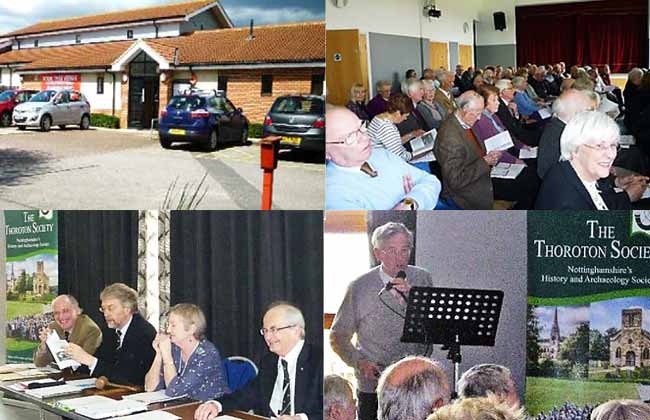
Clockwise from top left: the Village Hall, North Muskham; members waiting for the start of the meeting; the President and Officers of the Society; the speaker Dr David Crook. Photographs by Janet Wilson.
Again, we were very lucky with the weather – a spring-like Spring Meeting! The President, Adrian Henstock, welcomed members to North Muskham where we were accommodated in a very well provisioned and commodious hall. He then gave a most interesting potted history of North Muskham as a fairly quiet village surrounded within a few hundred yards by major transport routes of all kinds – the A1 and its predecessor the Old Great North Road, the railway line from London to York and, of course, the River Trent. North Muskham was one of the riverside villages which had a ferry, a diary record of its use being when Abigail Gawthern was ferried across from her country house in Holme to dine at Muskham Grange.
Professor Beckett then presented the annual report and remarked that it showed what a busy Society we were with many activities for members to be involved in – he hoped that those present were taking advantage of the range of opportunities. John Wilson, Honorary Treasurer, went through the accounts which he assured us were sound and continued to present no concerns. He informed the meeting that there had been a considerable increase in the sale of books, including those which comprised the Churm bequest, as well as copies of the Transactions. The major seller was the Newstead Abbey volume edited by Rosalys Coope and Pete Smith which, on its second printing, was still selling well in bookshops and now through international sales. Bookstall sales had also increased, and Margaret Trueman, Philip Jones and Penny Messenger were to be thanked for their management of this. Excursions were also doing well - full coaches were ensuring that they paid their way. This year the cost of Transactions was higher due to it being a bumper edition with many colour illustrations.
The Chair thanked John Wilson for his careful supervision of the Society’s finances and also Peter Bloomfield who was the Society’s Independent Examiner.
In his Chair’s remarks Professor Beckett commended the website for which Andy Nicholson was still the webmaster, even though he has moved to Wales. He continues to manage all the Society’s technological communications, quite possible these days. An innovation last year was the Geoffrey Bond Research Award, made possible through the generosity of our life-member. In this inaugural year we had a very good selection of applicants and two research projects were selected for funding: Matt Beresford who, with his teams of volunteers, are very active in the Southwell and Newark areas; and Hannah Nicholson, the youngest member of Council who is undertaking research under the auspices of Nottingham University. The Research Award is being funded by Mr Bond again this year and the Society is also contributing the same sum so that more projects can be supported. John also mentioned that there was to be a third Pevsner guide for Nottinghamshire. Sadly, the death of Geoffrey Oldfield, a long-standing active member and local historian, was reported by the Chair, as was that of Stan Smith, writer on history subjects, and Professor David Hey, who had lectured to the Society, most recently on family names. John mentioned a few of his highlights of the Thoroton year – he particularly enjoyed the Special Lecture by Jonathan Foyle at Kelham Hall and Ted Cantle’s outline of the ongoing Nottingham Castle project given at the Annual Luncheon. Professor Beckett concluded by thanking the officers for their contributions throughout the year.
Former President, and current Vice-President, Rosalys Coope was not in attendance for almost the first time since she was a very young member of the Society. Unfortunately, she recently had an accident at home and was ‘banned’ from venturing out for a while – Rosalys sent her greetings to members.
All officers of the Society were re-elected and those people retiring from Council, but eligible for renomination, were duly re-elected.
After the business had been concluded we were pleased that Dr David Crook OBE, Thoroton Council member and former Senior Archivist at the National Archives, gave a most interesting and timely account of the last days of King John who died in Newark Castle on 19th October 1216. David told us of the amazing whistle-stop tour he made during those last few weeks of his tumultuous life attempting to defend his rebel and invader threatened realm.
Tea was plentifully provided by Henson’s Catering of Claypole and drinks were made and served by a team from St Wilfrid’s Church, to whom we are most grateful for all the help they gave throughout the afternoon.
After tea members had the opportunity to visit the Grade I listed St Wilfrid’s church. Thanks to Valerie and David Mellors for welcoming us to the church, for telling us about its history and special features and setting out a fascinating display associated with St Wilfrid’s. Altogether another interesting and enjoyable spring meeting in a most welcoming village.
Barbara Cast, Honorary Secretary
REPORTS ON LECTURES
February 2016 - The Nora Witham lecture. ‘Jesse Boot, an Enlightened Entrepreneur’
Sophie Clapp, Archivist to the Boots Company
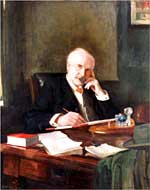
On Saturday 13th February, Sophie Clapp, Boots Company archivist, gave a fascinating talk on the life and work of Jesse Boot, Lord Trent, and the ethics that underlay many of his decisions. Jesse Boot was born in 1849. His father, John, was an agricultural worker and his mother, May, a teacher who also made herbal remedies. Owing to ill health, John moved into the town of Nottingham and opened a shop in Goosegate, with his wife, selling ‘botanics’ – herbal medicines chiefly bought by the poorer residents who lived in the immediate area. When Jesse was aged 10 his father died and he began to help his mother run the business, collecting and processing herbs and working in the shop. At the same time, he gained an elementary education at Agnes Mellors’ Free School which he attended until the age of 13. By 21 he was a partner in the company and began to expand the business by dealing in the increasingly fashionable ‘patent medicines’. The sale of medicines was, at this time, controlled by professional pharmacists, who usually sold such remedies at too high a price for Jesse’s customers so he began to buy medicines in bulk and sell them at a more affordable price. His success was seen as a threat by professional pharmacists not only because their prices were being undercut but also because he lacked their professional status. To counter this opposition, Jesse advertised aggressively and began to sell any goods (from tinned salmon to soda-siphons) that he could buy cheaply and sell inexpensively.
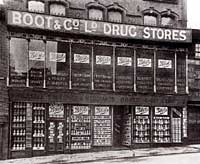
Large plate glass windows were installed in the Goosegate store in which he could display his stock (an innovation that pre-dates Selfridges which is usually credited with inventing window dressing) and an ‘American Elevator’ was installed so that shoppers could easily reach all four floors – another innovation as shops were usually only on the ground floor. A further innovation, and one that was much appreciated by the majority of his customers, was a Ladies’ Department complete with public lavatory. A change in the law in 1870 allowed companies to dispense prescription medicines (as opposed to simply sell patent remedies) providing a qualified pharmacist was employed. Jesse ‘poached’ Edwin Waring from a rival and began dispensing, again at a cut-price level better suited to his working-class customers. The business prospered and he expanded into other towns such as Sheffield, always opening shops in the poorer districts. Jesse also brought in improved working conditions for his employees, including a day off and apprenticeships. Later on the company organised staff outings, athletic events and a social club. Aware of his own limited education, in 1913 he started evening classes for employees who were allowed to leave early and were given a meal as a reward for attending. In the 1920s he opened a school for 14-16 year olds.
The early years of the twentieth century saw Jesse donate his fortune to a variety of good causes, particularly those with a lasting benefit. He made a large donation towards rebuilding the organ at the Albert Hall, and built Alms Houses for war veterans in Wilford. He was particularly concerned with outdoor pursuits and bought land on the embankment by the Trent which he then donated to the City for playing fields and a war memorial. He also donated the Highfields estate in Beeston as a new site for the University, as well as a park and outdoor lido.
Judith Mills
March 2016 - The Myles Thoroton Hildyard Lecture: ‘The Trees of Nottinghamshire’
Professor Charles Watkins, University of Nottingham
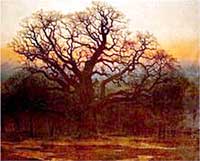
The Major Oak 1882 Andrew McCallum.
The lecture held on 12th March was the Myles Thoroton Hildyard Lecture, dedicated to the memory of Myles (1914-2005) who was for forty years (1961-2001) the President of the Thoroton Society and formerly the Honorary Secretary from 1956-60. He was interested in all aspects of the history of Nottinghamshire and is remembered with affection and respect by many members of the Society. And now to the lecture and another memorable one it was too. For a goodly number of those present, Professor Charles Watkins was not a stranger – he attended the 2014 lunch when he was our speaker, giving us a most informative, interesting and sometimes amusing talk on the Trees of Sherwood Forest. We welcomed him once again today to speak to us on the Trees of Nottinghamshire.
Charles is the Professor of Rural Geography at the University of Nottingham where he lectures on historical and cultural geography. He is also Chair of the Society for Landscape Studies, a Fellow of the Society of Antiquaries and a Trustee of the Sherwood Forest Trust. He has a number of books to his credit and had just published a volume entitled Trees, Woods and Forests when we met him at Edwinstowe and he was currently researching for a book on Trees in Art. Members were most interested in the number of artists who had found inspiration in Sherwood Forest, notably Andrew McCallum, a Nottingham born and educated artist who painted many striking scenes of trees, especially those of Sherwood Forest. His paintings can be found in the V&A as well as in Nottingham Castle Gallery - he was a favourite of Queen Victoria and was allotted a room in Windsor Castle whilst he was painting trees in the grounds.
Another person to draw inspiration from the trees of Sherwood Forest was Hayman Rooke, a retired major who made his home in Mansfield Woodhouse and is well-known as an antiquarian in the area. The Major Oak is named after him.
Professor Watkins informed us that the best fragments of Sherwood Forest are within 25 minutes of the City centre, including that part of Colwick Park which lies atop the cliff – a park within Sherwood Forest. We heard that, surprisingly, there were more woodlands in the county in the 1970s than in the 1830s.
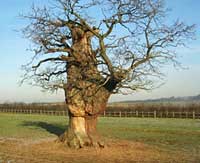
Ancient oak at Haywood Oaks. Photograph by Charles Watkins.
Ancient trees are still a feature of Sherwood Forest but owners in the past also often protected such trees for their antiquity and interest. However, there were many uses for the Notts woodlands such as the making of birch charcoal, an important source of industrial fuel - Sherwood Forest was vitally important for industry. It was also valuable for grazing and pannage for pigs, sheep and, in lesser numbers, long-horned cattle. Richard Neale of Edwinstowe attempted in the 17th century to control the numbers of pigs being let loose in his forest lands by imposing a limit of two per cottage. The traditional right to allow pigs to feed in the forest went on into the 18th century. Acorns and beech-mast were also commodities which could be sold.
Charles introduced us to many interesting people who lived, worked or wrote about Sherwood Forest. One such was Christopher Thomson of Edwinstowe who wrote an “Autobiography of an Artisan” in 1847. Thomson, we were told, was a one-man Mechanics Institute, establishing a library and free classes for the local inhabitants. He wrote in his Hallamshire Scrapbook of the rights which people had enjoyed from the forest lands half a century before he was writing and had now lost. It was he who recorded that the Major Oak had previously been used to keep fowls in but, because of the vast size, the fowls were banished and it was renamed.
A most interesting lecture from Professor Watkins – which managed to bring into a clear focus the varied ways in which the forest land and Nottinghamshire trees were so important to the county – valuable resources for us to treasure still.
Barbara Cast